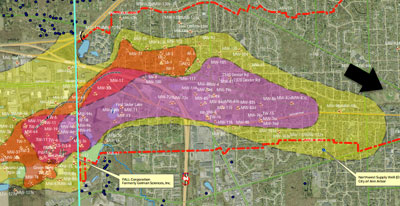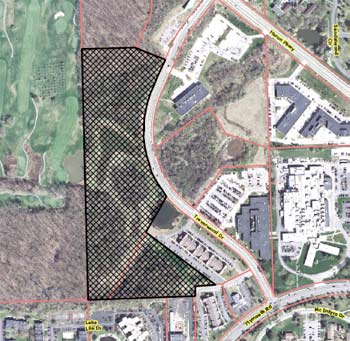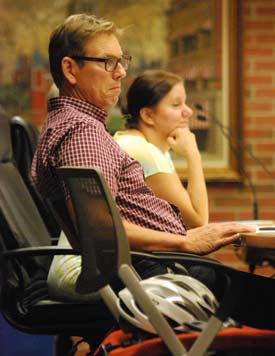The Ann Arbor city council’s vote last Monday on the appointment of Al McWilliams to the board of the Ann Arbor Downtown Development Authority was 6-5 on the 11-member body. A 6-5 vote for the Ann Arbor council is rare, and reflects a certain amount of controversy surrounding McWilliams’ appointment.

Fact: 6 is not actually greater than or equal to 8.
But in this column I’d like to leave aside the controversies that led to such a narrow split. Instead, I’d like to review the history of the legislative actions that led up to the 6-5 vote at the council’s Sept. 16, 2013 meeting. That review leads me to conclude that eight votes should have been required for approval.
A quick narrative summary goes like this: McWilliams was set to be nominated, then not actually nominated, but then nominated after all, then had his nomination “withdrawn,” and then finally had his nomination voted on by the council. But in the end, the six-vote majority was declared enough to confirm his membership on the DDA board, replacing Newcombe Clark, who made an employment-related move to Chicago after serving one four-year term.
Choice of the phrase “was declared enough to confirm” is not accidental. Even though the tally of six votes was deemed sufficient by the city clerk and mayor John Hieftje for approval of the motion, I think the vote actually required eight votes to pass.
Under the council’s rules, a nomination to a board or commission can’t be confirmed or approved before the next regular meeting of the council – unless eight members of the council vote for the confirmation. So the typical pattern is that a nomination is put forward at one meeting and the vote on confirmation is taken at the next regular meeting.
Hieftje explicitly stated at the council’s Sept. 3 meeting – during deliberations – that he was withdrawing the nomination of McWilliams. The matter was not “postponed” – as Hieftje described it at the Sept. 16 meeting – because the council did not vote on the McWilliams nomination at all, much less vote in a way that postponed consideration. It certainly would have been an option for the council to have entertained a motion to postpone. But councilmembers did not wind up voting on it at all, and Hieftje stated: “Okay, so I will withdraw it [McWilliams' nomination] tonight.”
Under any rational understanding of the nomination and confirmation procedure, Hieftje needed to take some affirmative action to put the nomination before the council again, which could have been done at the Sept. 16 meeting. Early in that meeting, during communications time, Hieftje indicated to the council he’d be bringing McWilliams’ nomination forward toward the end of the meeting, when nominations and confirmations are handled. The nomination was not on the council’s agenda as of 4 p.m. that day and came as a surprise to some councilmembers.
But instead of just placing the nomination of McWilliams before the council, Hieftje also asked the council on Sept. 16 to vote on confirmation, which it did – with the 6-5 outcome.
It’s puzzling that the online Legistar file for Sept. 16 containing the McWilliams nomination states that the nomination was “placed on the table for [the council's] consideration at the Sept. 3, 2013 Regular Session.” Reviewing my own notes, The Chronicle’s reporting and the CTN video, I can’t discern anything that happened at the Sept. 3 council meeting that could reasonably be described as placing McWilliams’ nomination on the table for consideration. Certainly councilmembers were asked to vote on Sept. 3 on a nomination that had been put before them on Aug. 19. But at the Sept. 3 meeting, the nomination was withdrawn by Hieftje for consideration by the council. And the Legistar record from Sept. 3 accurately reflects that: “Appointment taken off the table on 9/3/13.”
It’s certainly contemplated by the council’s rules that a nomination and confirmation vote can take place at the same meeting. So asking for the vote on Sept. 16 did not violate the council’s rules. It’s just that the 6-5 outcome on that vote should have been judged as not confirming the appointment of Al McWilliams to the DDA board – because it needed eight votes.
The problem here is not just a technical one. What’s the rationale for a higher voting threshold when a confirmation vote comes at the same meeting as the nomination? Granted, I think part of the rationale is to ensure enough time for an adequate review and vetting of a candidate – which arguably took place in the case of McWilliams’ nomination. But part of the rationale is not peculiar to appointments to boards and commissions. At least part of that general parliamentary principle is this: A higher standard is imposed when less notification has been given to the members of the council (and to the public).
When Hieftje withdrew McWilliams’ nomination at the Sept. 3 meeting, I think councilmembers and the public could have had a reasonable expectation that they’d be notified of an upcoming vote on his confirmation at least one meeting before a confirmation vote was taken. Absent that notification, the threshold for a successful vote should rise – to eight.
In this column, I’ll lay out some of the documentation in the online Legistar files that makes clear that the Sept. 16 nomination really was considered a new, fresh nomination that should have required either an eight-vote majority or a delay on voting until the following meeting.
I also have a suggestion for a remedy that does not involve Miley Cyrus. [Full Story]










